Peach Kernel Oil Downregulates Expression of Tissue Factor and Reduces Atherosclerosis in ApoE knockout Mice
Abstract
1. Introduction
2. Results
2.1. The Fatty Acid Composition of Peach Kernel Oil
2.2. Peach Kernel Oil Affects HUVEC Viability and Inhibits TNF-α-Induced TF mRNA Expression
2.3. Peach Kernel Oil Decreases TNF-α-Induced TF Protein Expression in HUVEC
2.4. Detection of TC, TG, HDL-C and LDL-C Levels
2.5. Peach Kernel Oil Reduced Aortic Atherosclerosis in ApoE KO Mice
2.6. Peach Kernel Oil Reduced the TF Protein Expression in Atherosclerotic Plaques
2.7. Peach Kernel Oil Reduced the Inflammatory Response In Vitro
3. Discussion
4. Materials and Methods
4.1. Extraction of Peach Kernel Oil
4.2. Analysis of Fatty Acid Composition
4.3. Cell Culture, Drug Treatment and Grouping
4.4. MTT Assay
4.5. Anti-Inflammatory Effect of Peach Kernel Oil
4.6. Quantitative Realtime-PCR (qRT-PCR)
4.7. Preparation of the Mouse Model of Atherosclerosis
4.8. Sacrifice and Processing of the Specimens of Mice
4.9. Blood Lipid Index
4.10. Histology
4.11. Detection of TF Protein Content by ELISA
4.12. Statistical Analysis
Author Contributions
Funding
Conflicts of Interest
Appendix A
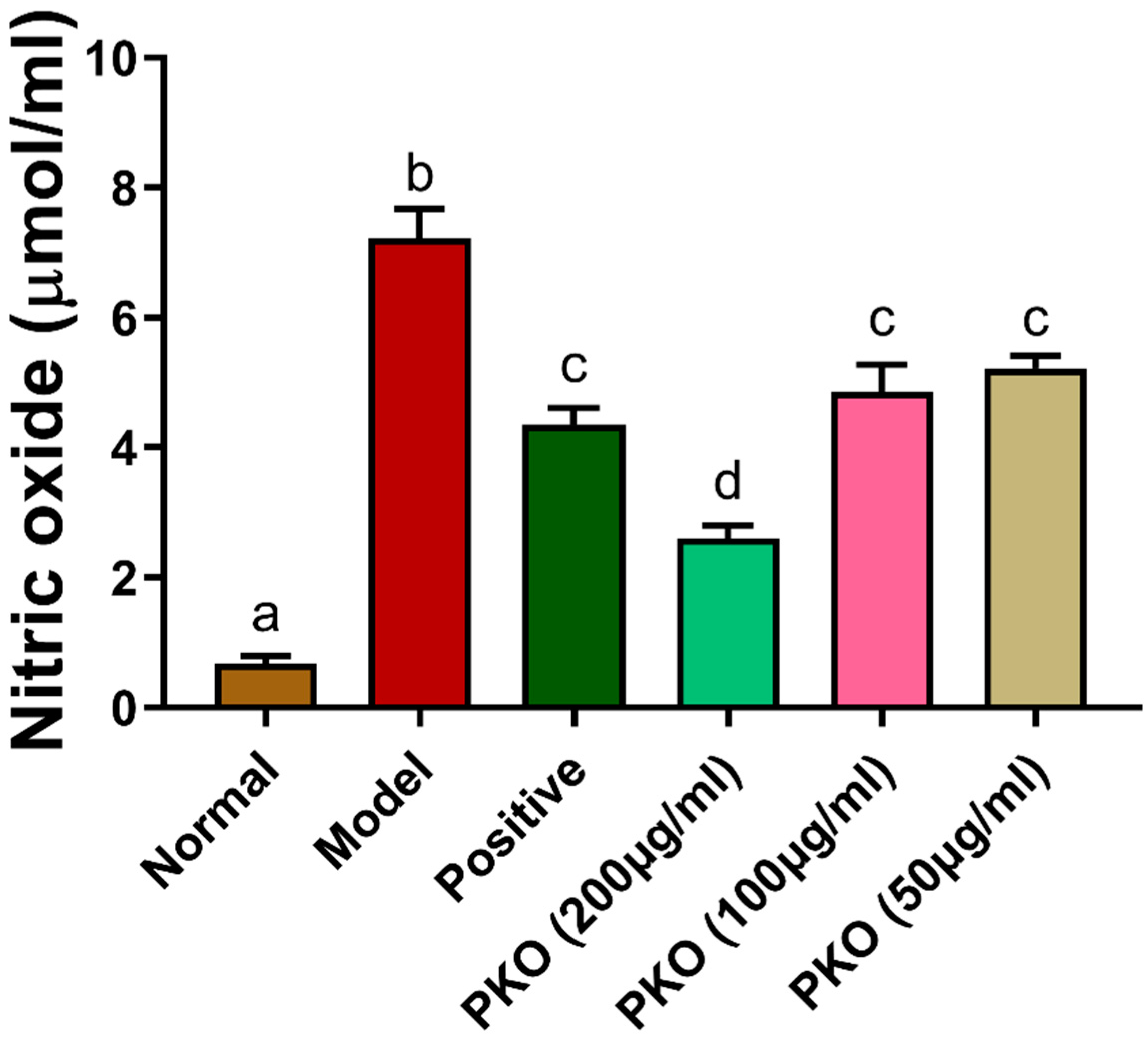
References
- Lusis, A.J. Atherosclerosis. Nature 2000, 407, 233–241. [Google Scholar] [CrossRef] [PubMed]
- French Study of Aortic Plaques in Stroke Group. Atherosclerotic disease of the aortic arch as a risk factor for recurrent ischemic stroke. N. Engl. J. Med. 1996, 334, 1216–1221. [Google Scholar] [CrossRef] [PubMed]
- Cines, D.B.; Pollak, E.S.; Buck, C.A.; Loscalzo, J.; Zimmerman, G.A.; McEver, R.P.; Pober, J.S.; Wick, T.M.; Konkle, B.A.; Schwartz, B.S.; et al. Endothelial cells in physiology and in the pathophysiology of vascular disorders. Blood 1998, 91, 3527–3561. [Google Scholar] [PubMed]
- Davignon, J.; Ganz, P. Role of endothelial dysfunction in atherosclerosis. Circulation 2004, 109, III27-32. [Google Scholar] [CrossRef] [PubMed]
- Del Turco, S.; Basta, G.; Lazzerini, G.; Chancharme, L.; Lerond, L.; De Caterina, R. Involvement of the tp receptor in TNF-α-induced endothelial tissue factor expression. Vasc. Pharmacol. 2014, 62, 49–56. [Google Scholar] [CrossRef] [PubMed]
- Zhou, P.; Lu, S.; Luo, Y.; Wang, S.; Yang, K.; Zhai, Y.; Sun, G.; Sun, X. Attenuation of TNF-α-induced inflammatory injury in endothelial cells by ginsenoside rb1 via inhibiting NF-κB, JNK and p38 signaling pathways. Front. Pharmacol. 2017, 8, 464. [Google Scholar] [CrossRef] [PubMed]
- Taubman, M.B.; Fallon, J.T.; Schecter, A.D.; Giesen, P.; Mendlowitz, M.; Fyfe, B.S.; Marmur, J.D.; Nemerson, Y. Tissue factor in the pathogenesis of atherosclerosis. Thromb. Haemost. 1997, 78, 200–204. [Google Scholar] [CrossRef]
- Grover, S.P.; Mackman, N. Tissue factor: An essential mediator of hemostasis and trigger of thrombosis. Arterioscler. Thromb. Vasc. Biol. 2018, 38, 709–725. [Google Scholar] [CrossRef]
- Tremoli, E.; Camera, M.; Toschi, V.; Colli, S. Tissue factor in atherosclerosis. Atherosclerosis 1999, 144, 273–283. [Google Scholar] [CrossRef]
- Toschi, V.; Gallo, R.; Lettino, M.; Fallon, J.T.; Gertz, S.D.; Fernández-Ortiz, A.; Chesebro, J.H.; Badimon, L.; Nemerson, Y.; Fuster, V. Tissue factor modulates the thrombogenicity of human atherosclerotic plaques. Circulation 1997, 95, 594–599. [Google Scholar] [CrossRef]
- Hasenstab, D.; Lea, H.; Hart, C.E.; Lok, S.; Clowes, A.W. Tissue factor overexpression in rat arterial neointima models thrombosis and progression of advanced atherosclerosis. Circulation 2000, 101, 2651–2657. [Google Scholar] [CrossRef] [PubMed]
- Luscher, T.F.; Barton, M. Biology of the endothelium. Clin. Cardiol. 1997, 20, II-3-10. [Google Scholar] [PubMed]
- Ludmer, P.L.; Selwyn, A.P.; Shook, T.L.; Wayne, R.R.; Mudge, G.H.; Alexander, R.W.; Ganz, P. Paradoxical vasoconstriction induced by acetylcholine in atherosclerotic coronary arteries. N. Engl. J. Med. 1986, 315, 1046–1051. [Google Scholar] [CrossRef] [PubMed]
- Wu, H.; Shi, J.; Xue, S.; Kakuda, Y.; Wang, D.; Jiang, Y.; Ye, X.; Li, Y.; Subramanian, J. Essential oil extracted from peach (prunus persica) kernel and its physicochemical and antioxidant properties. LWT Food Sci. Technol. 2011, 44, 2032–2039. [Google Scholar] [CrossRef]
- Rahma, E.; El-Aal, M.A. Chemical characterization of peach kernel oil and protein: Functional properties, in vitro digestibility and amino acids profile of the flour. Food Chem. 1988, 28, 31–43. [Google Scholar] [CrossRef]
- Litvinova, L.B. The effect of peach kernel oil on the sexual maturation of female rats. Eksp. Klin. Farmakol. 1998, 61, 43–45. [Google Scholar]
- Chua, Y.T.; Ang, X.L.; Zhong, X.M.; Khoo, K.S. Interaction between warfarin and Chinese herbal medicines. Singap. Med. J. 2015, 56, 11–18. [Google Scholar] [CrossRef]
- Kutlu, T.; Durmaz, G.; Ates, B.; Erdogan, A. Protective effect of dietary apricot kernel oil supplementation on cholesterol levels and antioxidant status of liver in hypercholesteremic rats. J. Food Agric. Environ. 2009, 7, 61–65. [Google Scholar]
- Minaiyan, M.; Ghannadi, A.; Asadi, M.; Etemad, M.; Mahzouni, P. Anti-inflammatory effect of Prunus armeniaca L.(apricot) extracts ameliorates tnbs-induced ulcerative colitis in rats. Res. Pharm. Sci. 2014, 9, 225. [Google Scholar]
- Hatters, D.M.; Peters-Libeu, C.A.; Weisgraber, K.H. Apolipoprotein E structure: Insights into function. Trends Biochem. Sci. 2006, 31, 445–454. [Google Scholar] [CrossRef]
- Rosenfeld, M.E.; Polinsky, P.; Virmani, R.; Kauser, K.; Rubanyi, G.; Schwartz, S.M. Advanced atherosclerotic lesions in the innominate artery of the apoe knockout mouse. Arterioscler. Thromb. Vasc. Biol. 2000, 20, 2587–2592. [Google Scholar] [CrossRef]
- Locatelli, S.; Lütjohann, D.; Schmidt, H.H.-J.; Otto, C.; Beisiegel, U.; von Bergmann, K. Reduction of plasma 24s-hydroxycholesterol (cerebrosterol) levels using high-dosage simvastatin in patients with hypercholesterolemia: Evidence that simvastatin affects cholesterol metabolism in the human brain. Arch. Neurol. 2002, 59, 213–216. [Google Scholar] [CrossRef] [PubMed]
- Scandinavian Simvastatin Survival Study Group. Randomised trial of cholesterol lowering in 4444 patients with coronary heart disease: The Scandinavian simvastatin survival study (4s). Lancet 1994, 344, 1383–1389. [Google Scholar]
- Libby, P. Atherosclerosis: Disease biology affecting the coronary vasculature. Am. J. Cardiol. 2006, 98, S3–S9. [Google Scholar] [CrossRef]
- Raber, J.; Wong, D.; Buttini, M.; Orth, M.; Bellosta, S.; Pitas, R.E.; Mahley, R.W.; Mucke, L. Isoform-specific effects of human apolipoprotein E on brain function revealed in apoe knockout mice: Increased susceptibility of females. Proc. Natl. Acad. Sci. USA 1998, 95, 10914–10919. [Google Scholar] [CrossRef]
- Kato, R.; Hayashi, M.; Aiuchi, T.; Sawada, N.; Obama, T.; Itabe, H. Temporal and spatial changes of peroxiredoxin 2 levels in aortic media at very early stages of atherosclerotic lesion formation in apoe-knockout mice. Free Radic. Biol. Med. 2018, 130, 348–360. [Google Scholar] [CrossRef] [PubMed]
- Drexler, H.; Hornig, B. Endothelial dysfunction in human disease. J. Mol. Cell. Cardiol. 1999, 31, 51–60. [Google Scholar] [CrossRef]
- Bonetti, P.O.; Lerman, L.O.; Lerman, A. Endothelial dysfunction: A marker of atherosclerotic risk. Arterioscler. Thromb. Vasc. Biol. 2003, 23, 168–175. [Google Scholar] [CrossRef] [PubMed]
- Conway, E.M.; Rosenberg, R.D. Tumor necrosis factor suppresses transcription of the thrombomodulin gene in endothelial cells. Mol. Cell. Biol. 1988, 8, 5588–5592. [Google Scholar] [CrossRef] [PubMed]
- Edgington, T.S.; Mackman, N.; Brand, K.; Ruf, W. The structural biology of expression and function of tissue factor. Thromb. Haemost. 1991, 66, 067–079. [Google Scholar] [CrossRef]
- Meisel, S.R.; Ouyang, Y.; Fishbein, M.C.; Edgington, T.S.; Ruan, X.M.; Cercek, B.; Shah, P.K.; Chaux, A. Prolonged hypercholesterolemia-induced tissue factor expression in rabbit vein grafts: A potential mechanism for graft failure. Coron. Artery Dis. 2010, 21, 97–103. [Google Scholar] [CrossRef] [PubMed]
- Maly, M.A.; Tomasov, P.; Hajek, P.; Blasko, P.; Hrachovinova, I.; Salaj, P.; Veselka, J. The role of tissue factor in thrombosis and hemostasis. Physiol. Res. 2007, 56, 685–695. [Google Scholar] [PubMed]
- Nadir, Y.; Brenner, B.; Zetser, A.; Ilan, N.; Shafat, I.; Zcharia, E.; Goldshmidt, O.; Vlodavsky, I. Heparanase induces tissue factor expression in vascular endothelial and cancer cells. J. Thromb. Haemost. 2006, 4, 2443–2451. [Google Scholar] [CrossRef] [PubMed]
- Gerthoffer, W.T. Mechanisms of vascular smooth muscle cell migration. Circ. Res. 2007, 100, 607–621. [Google Scholar] [CrossRef] [PubMed]
- Wang, Y.S.; Li, X.J.; Zhao, W.O. Trem-1 is a positive regulator of TNF-α and IL-8 production in u937 foam cells. Bosn. J. Basic Med. Sci. 2012, 12, 94–101. [Google Scholar] [CrossRef] [PubMed]
- QI, Z.-X.; Lei, C. Effect of chinese drugs for promoting blood circulation and eliminating blood stasis on vascular endothelial growth factor expression in rabbits with glucocorticoid-induced ischemic necrosis of femoral head. J. Tradit. Chin. Med. 2009, 29, 137–140. [Google Scholar] [CrossRef]
- Tanaka, S.; Takahashi, A.; Onoda, K.; Kawashima, K.; Nakaura, S.; Nagao, S.; Endo, T.; Ohno, Y.; Kawanishi, T.; Takanaka, A.; et al. Toxicological studies on biological effect of herbal drug extracts on rats and mice—Peony root, peach kernel, Japanese angelica root and cnidium rhizome. Yakugaku Zasshi 1983, 103, 937–955. [Google Scholar] [CrossRef]
- Livak, K.J.; Schmittgen, T.D. Analysis of relative gene expression data using real-time quantitative PCR and the 2−ΔΔCT method. Methods 2001, 25, 402–408. [Google Scholar] [CrossRef]
- Zetterqvist, A.V.; Berglund, L.M.; Blanco, F.; Garcia-Vaz, E.; Wigren, M.; Dunér, P.; Andersson, A.-M.D.; To, F.; Spegel, P.; Nilsson, J. Inhibition of nuclear factor of activated T-cells (NFAT) suppresses accelerated atherosclerosis in diabetic mice. PLoS ONE 2013, 8, e65020. [Google Scholar] [CrossRef]
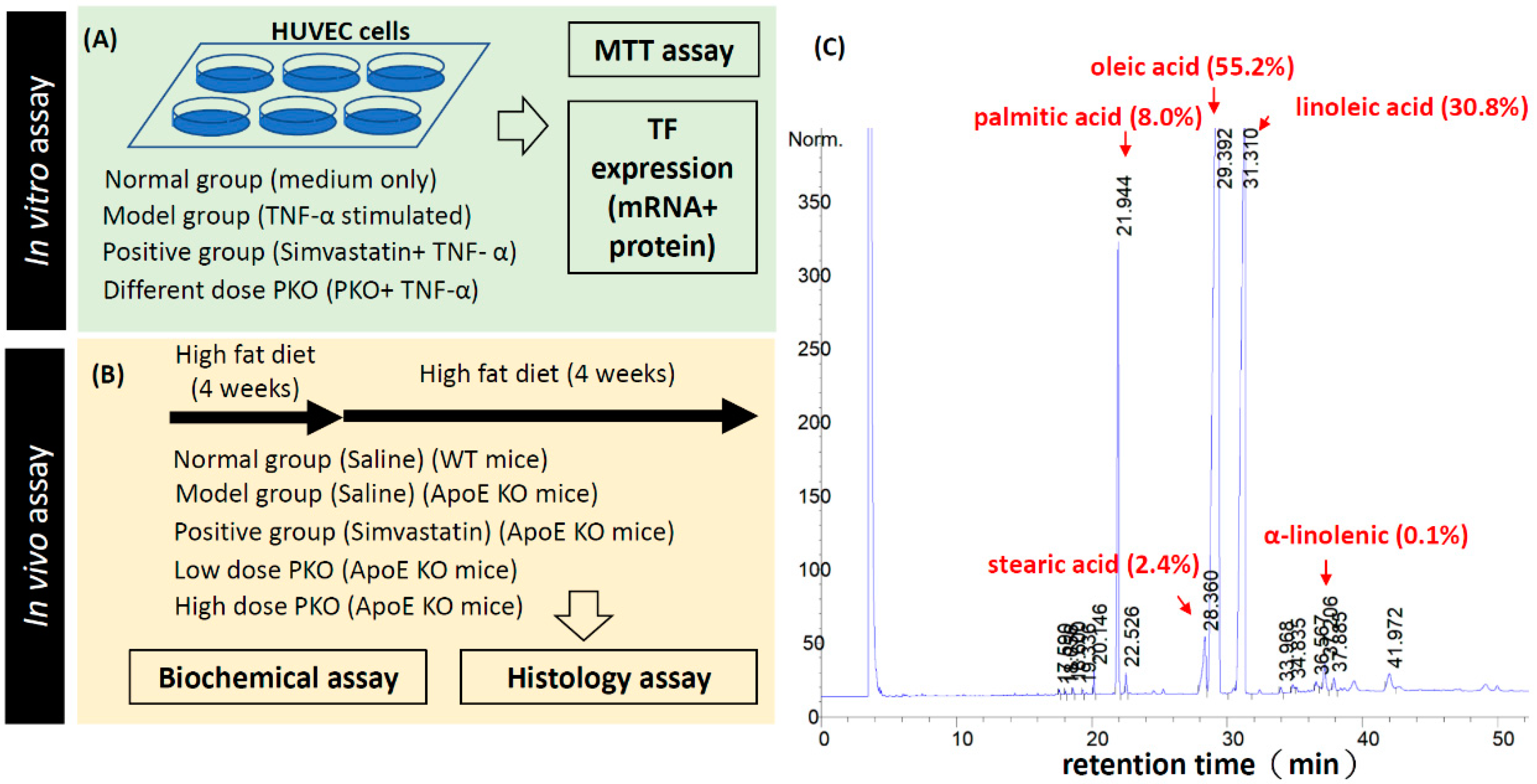
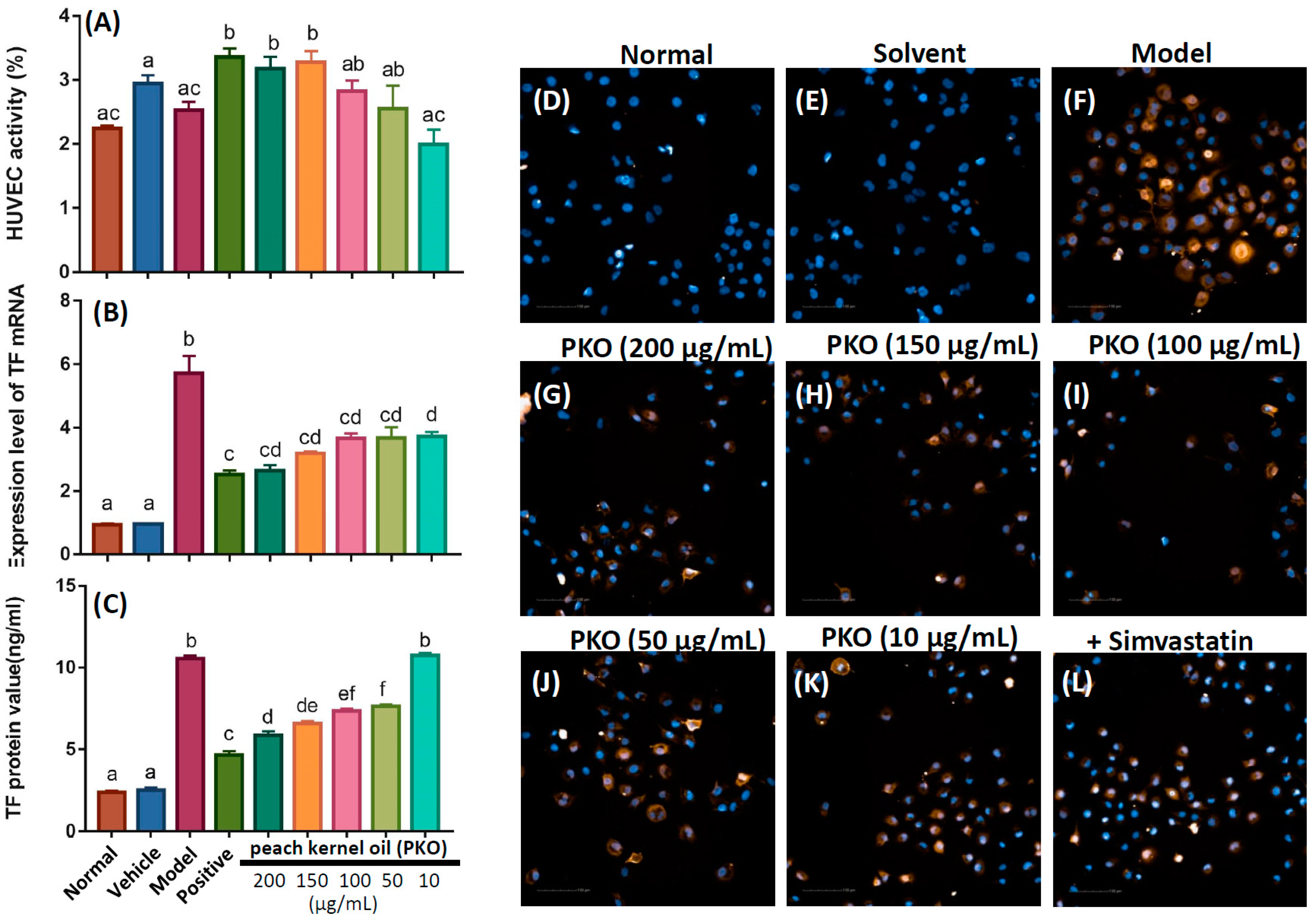
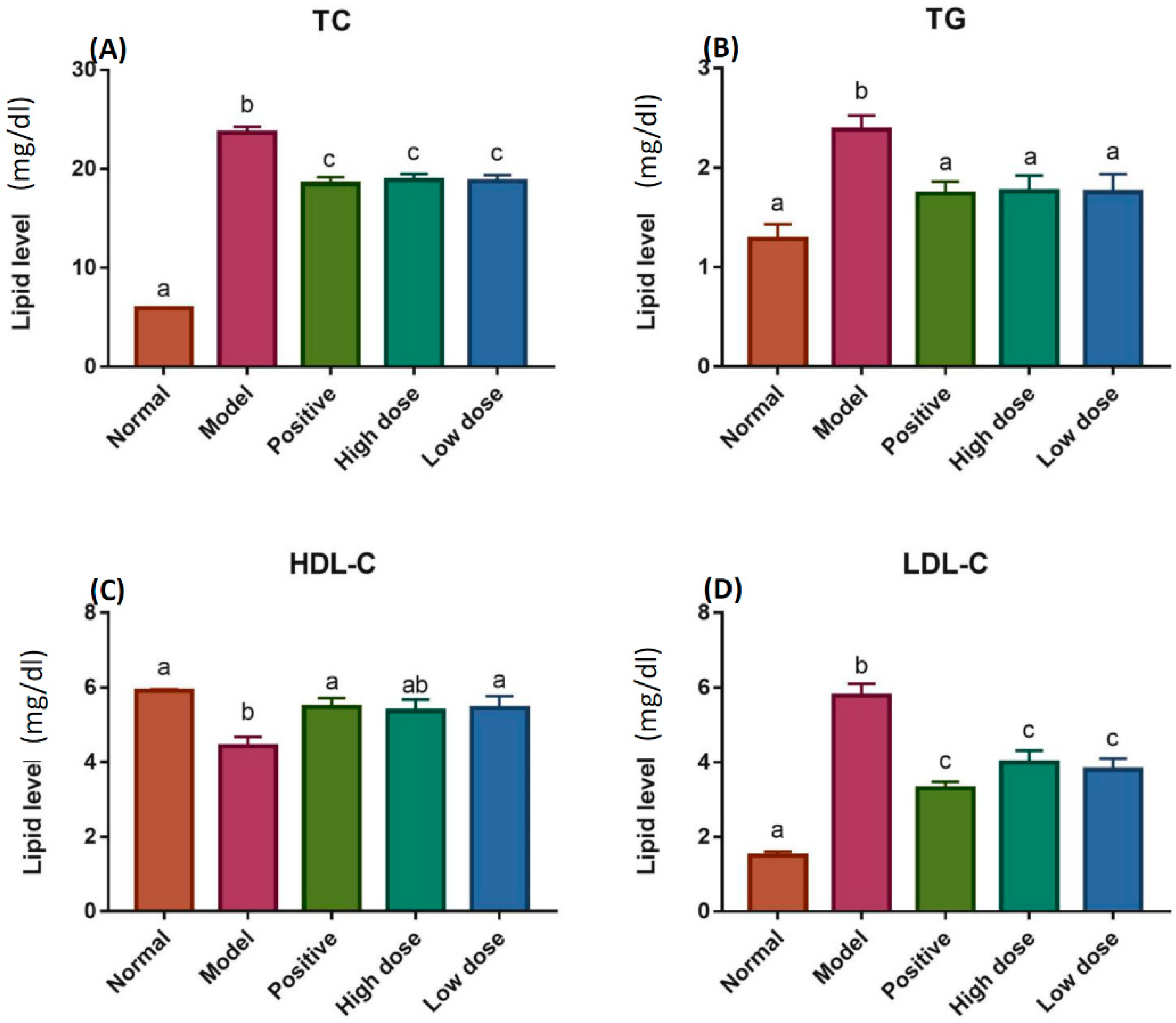
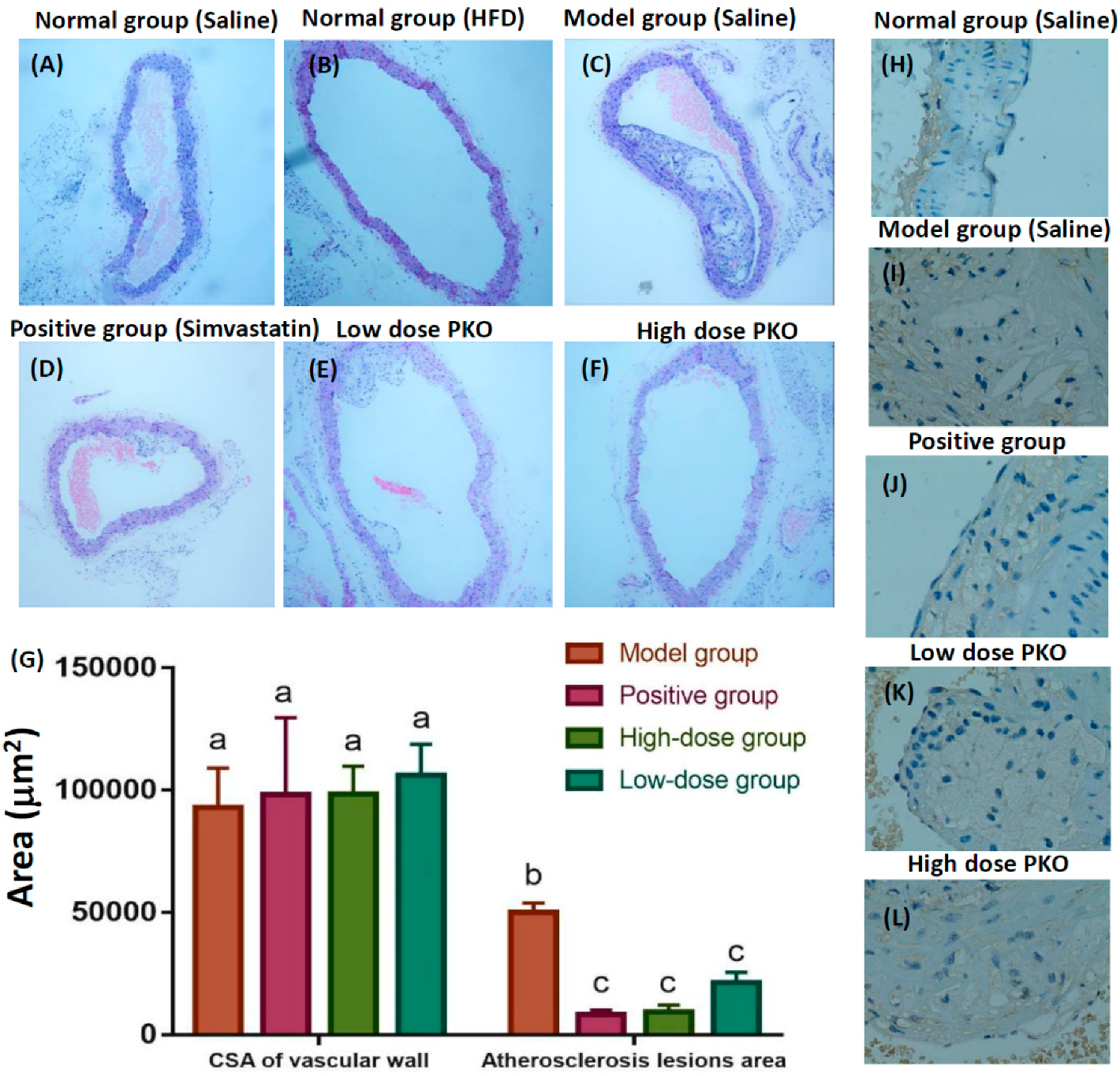
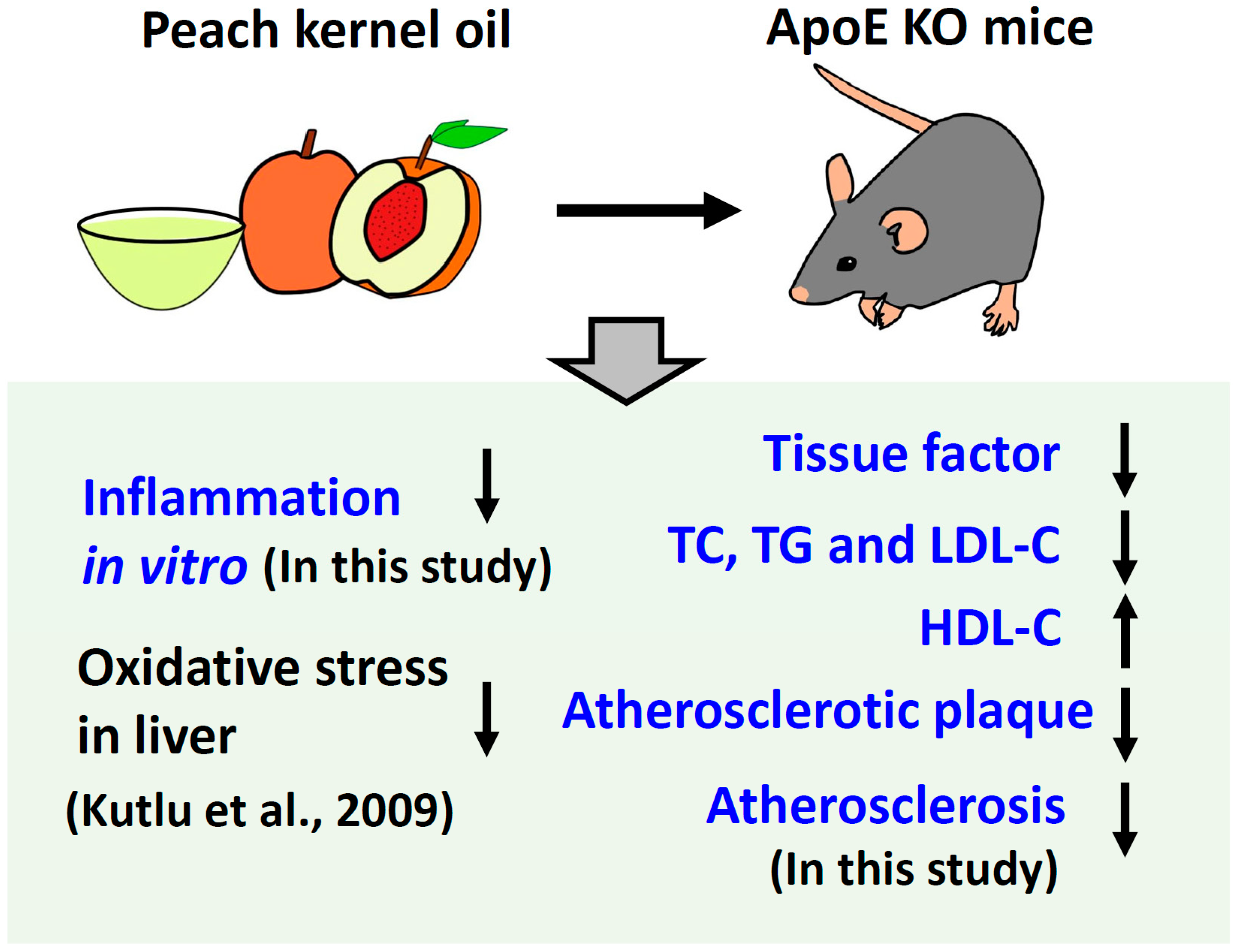
| Grouping | Atherosclerosis Lesions Area (μm2) | Cross-Sectional Area of Vascular Wall (μm2) | Atherosclerosis Lesions Area/Cross-Sectional Area of Vascular Wall |
|---|---|---|---|
| Model group | 50,176 ± 5348 a | 93,118 ± 22,508 a | 0.547 ± 0.074 a |
| Positive group | 8298 ± 2629 b | 98,249 ± 44,394 a | 0.087 ± 0.013 b |
| High-dose PKO group | 9396 ± 4028 b | 98,592 ± 15,878 a | 0.093 ± 0.025 b |
| Low-dose PKO group | 21,418 ± 5807 b | 106,322 ± 17,706 a | 0.199 ± 0.021 b |
© 2019 by the authors. Licensee MDPI, Basel, Switzerland. This article is an open access article distributed under the terms and conditions of the Creative Commons Attribution (CC BY) license (http://creativecommons.org/licenses/by/4.0/).
Share and Cite
Hao, E.; Pang, G.; Du, Z.; Lai, Y.-H.; Chen, J.-R.; Xie, J.; Zhou, K.; Hou, X.; Hsiao, C.-D.; Deng, J. Peach Kernel Oil Downregulates Expression of Tissue Factor and Reduces Atherosclerosis in ApoE knockout Mice. Int. J. Mol. Sci. 2019, 20, 405. https://doi.org/10.3390/ijms20020405
Hao E, Pang G, Du Z, Lai Y-H, Chen J-R, Xie J, Zhou K, Hou X, Hsiao C-D, Deng J. Peach Kernel Oil Downregulates Expression of Tissue Factor and Reduces Atherosclerosis in ApoE knockout Mice. International Journal of Molecular Sciences. 2019; 20(2):405. https://doi.org/10.3390/ijms20020405
Chicago/Turabian StyleHao, Erwei, Guofeng Pang, Zhengcai Du, Yu-Heng Lai, Jung-Ren Chen, Jinling Xie, Kai Zhou, Xiaotao Hou, Chung-Der Hsiao, and Jiagang Deng. 2019. "Peach Kernel Oil Downregulates Expression of Tissue Factor and Reduces Atherosclerosis in ApoE knockout Mice" International Journal of Molecular Sciences 20, no. 2: 405. https://doi.org/10.3390/ijms20020405
APA StyleHao, E., Pang, G., Du, Z., Lai, Y.-H., Chen, J.-R., Xie, J., Zhou, K., Hou, X., Hsiao, C.-D., & Deng, J. (2019). Peach Kernel Oil Downregulates Expression of Tissue Factor and Reduces Atherosclerosis in ApoE knockout Mice. International Journal of Molecular Sciences, 20(2), 405. https://doi.org/10.3390/ijms20020405







